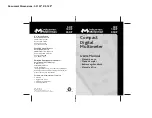
198
Measurement Speed and Accuracy Trade-offs
Store the Readings in
Multimeter RAM
Instead of Sending
them Directly to the
Computer
There is a major difference between
INIT;:FETCh?
and
READ?
after a
CONFigure
command.
INIT;:FETCH?
When the
INITiate
command is sent to the E1412A, the multimeter will store
up to 512 readings in Multimeter RAM. For example:
CONF:VOLT:DC
SAMP:COUN 200
INIT
! Stores 200 readings in RAM
FETC?
! Transfers readings to output buffer
The E1412A then takes the readings as soon as its trigger conditions have
been satisfied and stores them in internal memory (RAM). For example, if
the trigger source is
IMMediate
, the readings are started once
INITiate
is
executed. If the trigger source is
EXT
, then the readings are started when an
external trigger is received.
The
FETCh?
command causes the readings that have been stored in the
multimeter RAM to be placed in the multimeter's output buffer so they can be
retrieved and sent over the GPIB bus (or other I/O interface such as VXLink).
No readings are output until all readings have been taken and stored in internal
memory (RAM). This results in a burst-then-transfer mode of operation. The
multimeter can store a maximum of 512 readings in its internal memory.
READ?
The
READ
? command does not store readings in internal memory (RAM)
like the
INITiate
command does. For example:
CONF:VOLT:DC
SAMP:COUN 200
READ?
! Takes 200 readings and puts them in the output buffer
The
READ?
command causes the E1412A Multimeter to start taking readings
as soon as the trigger requirements have been met. For example, if the trigger
source is
IMMediate
, the readings are started immediately. If the trigger source
is
EXT
, then the readings are started when an external trigger is received. The
multimeter immediately places those readings in the multimeter's output
buffer so they can be retrieved via the GPIB bus (or other I/O interface such
as VXLink) by the controller. If the controller cannot take the readings from
the output buffer fast enough, the multimeter will suspend taking
measurements until there is room to place the readings in the output buffer.
You can have a variable reading rate if your controller is busy doing other
tasks instead of emptying the output buffer to make room for more readings.
Summary of Contents for Agilent E1412A
Page 2: ......
Page 10: ...8 Contents Notes...
Page 14: ...12 Notes...
Page 15: ...13 Notes...
Page 16: ...14 Notes...
Page 26: ...24 Agilent E1412A Multimeter Module Setup Chapter 1 Notes...
Page 194: ...192 Agilent E1412A Multimeter Error Messages Appendix B Notes...
Page 201: ...Index 199 Index Agilent E1412A User s Manual and SCPI Programming Guide...















































